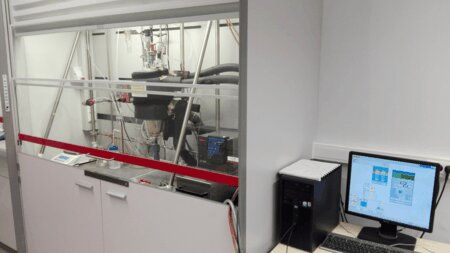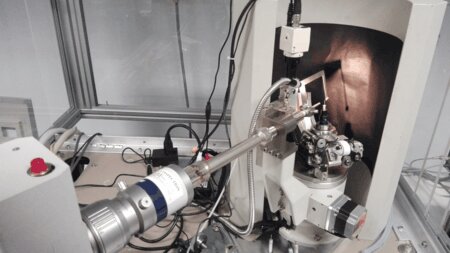Analytics offer
iPRACS has an extensive analytical and synthesis lab, which we use in a variety of strategic as well as applied research and development trajectories. Not only do we offer service measurements on our key equipment, as listed below, but stronger are our capabilities for a holistic approach to industrial problems, whereby we combine various expertise/analytical angles to solve a variety of chemical challenges. Therefore, we can be contacted for a quote regarding various analytical techniques, yet a clear vision on how to analyze the challenge is not a precondition for our first contact! Other than the standard analytic equipment for synthesis labs, we offer the following analytical services using state-of-the-art equipment, in our core expertise domains:
Upscaling of chemical reactions
iPRACS has several reaction suites, ranging from ad-hoc standard glassware setups, to 3-to-5 parallel 100-500 mL heated and intertisized reaction flasks, up to a 1 L and 5 L completely software controlled double wall reaction suite. This controlled reactor can be pH controlled, temperature controlled, and dosing of reagents can be done automatically. The combination of these reaction setups allows for a design of experiments aimed at a first upscaling step from first bench-scale lab results. This is mostly crucial in collaborative efforts, whereby partner research teams are anxious to test physico-chemical properties of new chemicals and materials at a reproducible scale.
Please contact Prof. Dr. Pieter Billen (pieter.billen@uantwerpen.be) to obtain more information about this service.
Thermal materials and reactions analysis
iPRACS has several thermal analysis instruments available.
- Thermogravimetric analysis (TGA - TA Instruments Q5000) provides a microgram balance in a computer-controlled oven, and shows decomposition over a range of temperatures. This allows to study decomposition temperatures and stability, and sometimes to infer what part of the structure disappears first (e.g. water content), and from what temperature onwards. The amount of material needed is typically 20mg for a measurement.
- Differential Scanning Calorimetry (DSC -TA Instruments Q2000) compares the heat flow between a sample and a reference cup in a computer-controlled oven. This allows to detect both first- (melting, evaporation) and second-order (e.g. glass transitions) phase transitions in materials, as well as endo- and exothermic chemical reactions (e.g. decomposition) that take place in the DSC cup. Various cups can be provided for pressures up to 40atm. The amount of material needed is typically 20mg for a measurement.Reaction calorimeter.
- The SYSTAG 2310 Reaction calorimeter is an instrument to determine the reaction heat under normal process conditions, and project these data into scenarios where e.g. the cooling fails, or a reagent is added faster than expected. The data can be used as input for classifying a process in one of Stoessel’s criticality classes and thus make a safety assessment for the process, to see if adaptations to the process are needed. Reaction calorimetry is an indispensable part of a safety study, and the SYSTAG 2310 calorimeter in particular allows to deal with viscous mixtures through the utilization of the heat balance principle for reaction heat measurement.
Please contact Prof. Christophe Vande Velde (christophe.vandevelde@uantwerpen.be) to obtain more information about this service.

X-ray crystallography
X-ray diffraction is a technique that allows to probe long-range order in materials. We have two pieces of equipment:
- A powder diffractometer, which allows for recognition of materials (or mixtures of materials or phases) through fingerprinting a 1-D diffractogram, in most cases determination of the unit cell of a material, as well as giving indications of crystallite size and strain in a material. The sample necessary is a few 100s of mg, and the technique is non-destructive.
- A single crystal diffractometer (Rigaku R-Axis II with a Cu anode microsource and focusing optics), which allows to determine all the details of the internal structure of a material, and is the gold standard for characterization of organic and inorganic material, including absolute structure of chiral materials in most cases. The only requirement is that a single crystal is available of approximately 0.15mm in all directions. Various levels of service are available – from a cooperation where we measure your structure and we publish jointly, to providing the x-ray data, refinement and interpretation for your internal report, to simply providing the dataset.
Please contact Prof. Christophe Vande Velde (christophe.vandevelde@uantwerpen.be) to obtain more information about this service.

Heterogenous (colloidal systems) - laser diffraction methods
For many materials that we use in daily live, particle size (distribution) is one of the most important parameters that influence the properties of this material. Think for example of the colour intensity of toner, the chemical reactivity of a heterogeneous catalyst or the electrostatic charging of powders.
We have two types of instruments to measure particle size distribution:
- Laser diffraction measures particle size distributions by measuring the angular variation in intensity of light scattered as a laser beam passes through a dispersed particulate sample. The angular scattering intensity data is then analysed to calculate the size of the particles responsible for creating the scattering pattern, using the Mie theory of light scattering.
- Differential sedimentation is based on Stokes' law. Stokes' law is used to determine (spherical) particle size distributions by measuring the time required for the particles to settle a known distance in a fluid of known viscosity and density. The sedimentation can be accelerated by using centrifugal forces. This makes it possible to decrease sedimentation time and extends the range of sedimentation analysis to much smaller particles.
Please contact Prof. Serge Tavernier (serge.tavernier@uantwerpen.be) for more details.